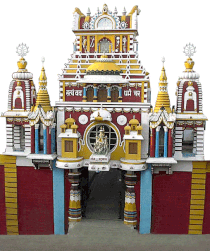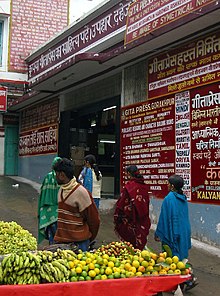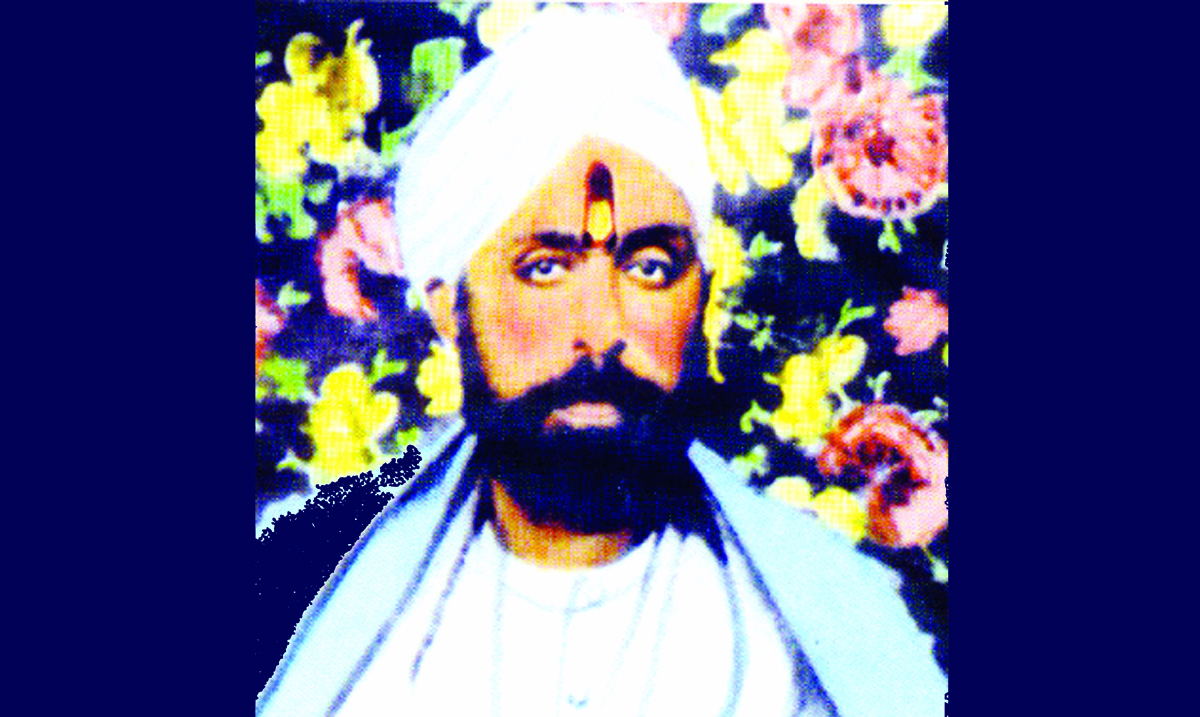Gita Press
| Founded | 29 April 1923; 96 years ago in Gorakhpur, India |
|---|---|
| Founder | Jay Dayal Goyanka Ghanshyam Das Jalan |
| Country of origin | India |
| Headquarters location | Gorakhpur, Uttar Pradesh |
| Distribution | Worldwide |
| Publication types | Hindu Religious Books and Kalyan Masik |
| Nonfiction topics | Sanatana Dharma or Hinduism |
| No. of employees | 350 |
| Official website | www |
Gita Press is the world's largest publisher of Hindu religious texts.[1] It is located in Gorakhpur city of India's Uttar Pradesh state. It was founded in 1923 by Jaya Dayal Goyanka and Ghanshyam Das Jalan for promoting the principles of Sanatana Dharma. Hanuman Prasad Poddar better known as "Bhaiji" was the founding and the lifetime editor of its noted magazine who also wrote articles with his pen name "SHIV", Kalyan.[2] It started publishing in 1927, with a circulation of 1,600 copies and at present its print order had reached 250,000 (in 2012). The Gita Press archives contain over 3,500 manuscripts including over 100 interpretations of the Bhagwad Gita.[3]
Seth Jaya Dayal Goyanka, Shri Hanuman Prasad Poddar and Shri Ghanshyam Das Jalan, Gita preachers set up the Gita Press on 29 April 1923, as a unit of Gobind Bhawan Karyalaya registered under the Societies Registration Act, 1860 (presently governed by the West Bengal Societies Act, 1960). Five months later it acquired its first printing machine for Rs 600. Since its establishment, the Gita Press has published approximately 410 million copies of the Gita (in different editions) and 70.0 million copies of the Ramcharitamanas, at subsidized prices.[3]
It temporarily shut down in December 2014 over wage issues,[4] but work resumed a few days later.[5]
Publications
Magazines
- Kalyan (in Hindi) is a monthly magazine being published since 1927. It has articles devoted to various religious topics promoting uplifting thought and good deeds. Writings by Indian saints and scholars are regularly published in the magazine.
- Kalyana-Kalpataru (in English) is also a monthly and has been published since 1934. Its contents are similar to Kalyan.
Neither of these magazines runs any advertisements.
Religious texts
These texts are published in Sanskrit, Hindi, Marathi, English, Kannada, Tamil, Telugu, Gujarati, Bengali, Oriya and other languages of India.
- Shrimad Bhagvad Gita (several formats)
- The Mahabharata
- Shri Ramcharitmanas by Tulsidas (several formats), Telugu version (2002) [6]
- Other works by Tulsidas
- Valmiki Ramayana (several formats)
- Scriptures (Puranas, Upanishads and others)
- Works by Soordas
- Books by Swami Ramsukhdas
- Books by Hanuman Prasad Poddar
- Books by Jaydayal Goyandaka
Other publications
- Bhakta-Gathas and Bhajans
- Small books geared towards children
Branches
Gita Press has the branches and stalls in following locations. Most of the stalls are operated in railway platforms except Churu and Nadiyad. Churu has a stall near Rishikul Brahmacharyashram vedic school and Nadiyad has a stall near Santram Temple.
| Branches | Address | Stall Operations |
|---|---|---|
| Bengaluru | 7/3, 2nd Cross, Lalbagh Road Bangalore - 560027 | Bangalore, Yashwantpur, SSPN, Hubli |
| Coimbatore | Gita Press Mansion 8/1 M, Racecourse, Coimbatore - 641018 ( Tamilnadu) | NIL |
| Bhilwara | G-7, Aakar Tower, C Block, Opp. Harsh Palace, Gandhi Nagar, Bhilwara (Raj.)- 311001 | NIL |
| Cuttack | Bharatiya Towers, Badam Badi, Cuttack-753009 | Cuttack, Bhubanshwar |
| Delhi | 2609, Nayi Sarak, Delhi-110006 | Delhi, Nijamuddin, New Delhi, Bikaner, Churu |
| Rishikesh | Gita Bhavan, P.O. Swargashram, Rishikesh-249304 | NIL |
| Haridwar | Sabjimandi, Motibazar, Haridwar-249401 | Haridwar |
| Hyderabad | 41, 4-4-1; Dilshad Plaza, Sultan Bazar, Hyderabad-500095 | Secunderabad, Vijaywada |
| Indore | G-5, Shree Vardhan, 4 R.N.T. Marg, Indore-452001 | Indore |
| Jalgaon | 7, Bhim Singh Market, Near Railway Station, Jalgaon-425001 | Aurangabad |
| Kanpur | 24/55, Birhana Road, Kanpur-208001 | Kanpur, Lucknow, Kota |
| Kolkata | 151, Mahatma Gandhi Road, Kolkata-700007 | Kolkata, Sealdah, Howrah, Dhanbad, Kharagpur |
| Mumbai | 282,Samaldas Gandhi Marg (Princess Street), Near Marine Lines Station, Mumbai-400002 | NIL |
| Nagpur | Shriji Kripa Complex, 851, New Etawari Road, Nagpur-440002 | Gondia |
| Patna | Ashok Rajpath, Opposite Women's Hospital, Patna - 800004 | Patna |
| Raipur | Mittal Complex,Ganjpara, Telghani Chowk(Chhattisgarh), Raipur- 492009 | Raipur |
| Ranchi | Cart Sarai Road, Upper Bazar, First Floor Birla Gaddi, Ranchi-834001 | Ranchi |
| Surat | Vaibhav Apartment, Opposite Nutan Niwas, Bhatar Road, Surat-395001 | Ahmedabad, Vadodara, Rajkot, Jamnagar, Bharuch, Nadiyad |
| Varanasi | 59/9, Nichibag, Varanasi-221001 | Mughal Sarai |
| Chennai | Electro House No. 23, Ramnathan Street, Kilpauk, Chennai-600010 (T.N.) | NIL |
| Gorakhpur | Gita Press, P.O. Gita Press, Gorakhpur - 273005 | Chapra, Siwan, Muzaffapur, Gorakhpur, Gondia, Jabalpur, Samastipur |
Gita Press Art Gallery (Lila chitra mandir)
The Art Gallery has the lilas ( works or plays ) of Shri Rama and Shri Krishna portrayed in 684 paintings by famed artists of the past and present. Other paintings, including Mewari style paintings of the Shri Krishna Lila are also on exhibit. The entire 700 verses of the Bhagvad Gita are displayed on marble plaques affixed to the walls.
Affiliated organizations
The Gita Press is part of the Govind Bhawan Karyalaya, Kolkata. Other affiliated institutions are:
- Gita Bhavan, Muni Ki Reti, Rishikesh
- Rishikul-Brahmacharya Ashram (Vedic school), Churu, Rajasthan.
- Ayurved Sansthan (producer of Ayurvedic medicines), Rishikesh.
- Gita Press Seva Dal (relief organization for natural calamities).
- Hasta Nirmit Vastra Vibhag (producer of handloom made clothes).
- Bhartiya Gramodyog Vastra Bhandar (first retailer of Gita Press in Mumbai).
See also
References
- "Thulasidas Ramayana". The Hindu. 21 May 2002. Retrieved 5 July 2018.








